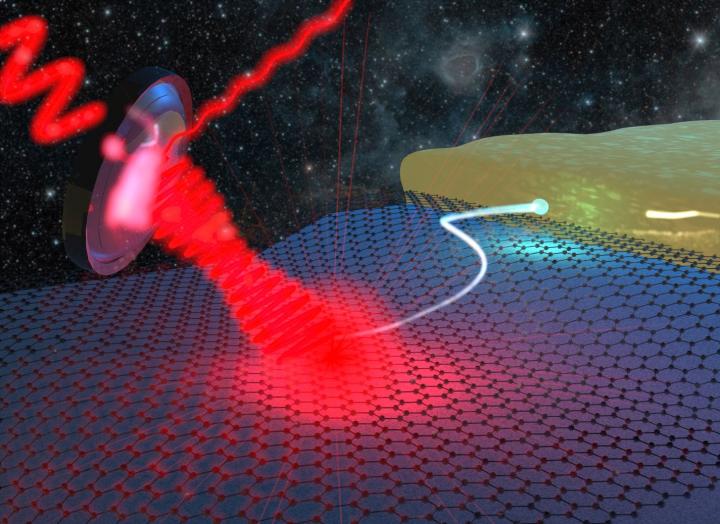
Terahertz Heterodyne Detection with Graphene Could Power Space Telescopes
Researchers at Chalmers University of Technology have demonstrated a terahertz (THz) detector made from graphene for use in next-generation astronomy detectors. A near zero-electron scenario, called Dirac point, was realized in graphene by assembling electron-accepting molecules on its surface. Graphene uniformly doped to the Dirac point was found to enable sensitive and wide-band coherent detection of signals from 90 to 700 gigahertz (GHz) and, prospectively, across the entire THz range. The researchers’ findings indicate that engineered graphene could be a useful material for THz heterodyne detection.
For their experiment, the researchers mixed THz signals using graphene. One signal was a high-intensity wave at a known THz frequency, generated by a local oscillator. The second signal was a faint THz signal that mimicked the THz waves coming from space. After these signals were mixed, the graphene produced an output wave at a much lower frequency, known as the intermediate frequency, that could be analyzed using standard, low-noise GHz electronics.

The image depicts a schematic of THz heterodyne detection with graphene. In this, two THz waves (red) are coupled into graphene, where they are combined or mixed. One of the waves is a high-intensity signal generated by a local THz light source (i.e., a local oscillator), at a known THz frequency. The other signal is a faint THz wave that mimics the waves coming from space. Courtesy of Hans He.
The higher the intermediate frequency can be, the higher bandwidth the detector is believed to have, the team said. A high bandwidth is necessary to accurately identify motions inside the celestial objects.
Professor Sergey Cherednichenko said, “According to our theoretical model, this graphene THz detector has a potential to reach quantum-limited operation for the important 1 to 5 THz spectral range. Moreover, the bandwidth can exceed 20 GHz, larger than the 5 GHz that the state-of-the-art technology has to offer.”
For the local oscillator to achieve a trustable detection of faint THz signals, only a small amount of power (<100 pW) was needed. Such a low power requirement — a few orders of magnitude lower than superconductors require — could enable quantum-limited THz coherent detector arrays, opening the door to the possibility of 3D imaging of the universe.
“This graphene-based technology has enormous potential for future space missions that, for example, aim at unveiling how water, carbon, oxygen, and life itself came to Earth,” professor Elvire De Beck said. “A lightweight, power-effective 3D imager that is quantum-limited at terahertz frequencies is crucial for such ambitious tasks. But, at the moment, THz 3D imagers are simply not available.”
Beyond superconductors, there are few materials that can fulfill the requirements needed to make ultrasensitive, ultrafast THz detectors for astronomy. “Graphene might be the only known material that remains an excellent conductor of electricity/heat even when having effectively no electrons,” professor Samuel Lara-Avila said. “Our results show that graphene is an exceptionally good material for THz heterodyne detection when doped to the Dirac point.”
The core of the THz detector is a system of graphene and molecular assemblies. “This is, in itself, a novel composite 2D material that deserves deeper investigation from a fundamental point of view, as it displays a whole new regime of charge/heat transport governed by quantum-mechanical effects,” professor Sergey Kubatkin said.
The research was published in Nature Astronomy (https://doi.org/10.1038/s41550-019-0843-7).
This is an experimental demonstration of THz wave detection with charge-neutral epitaxial graphene. Courtesy of Samuel Lara-Avila.
Published: September 2019